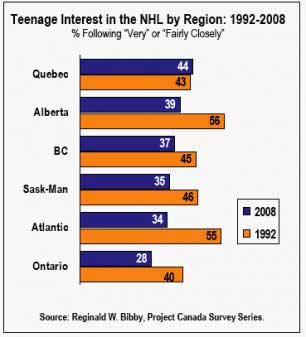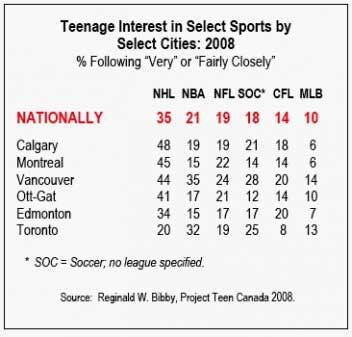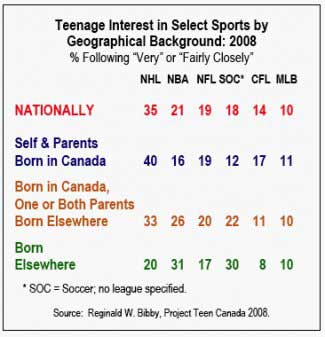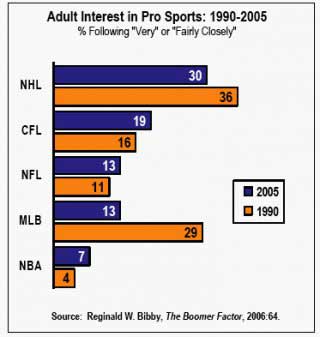Every league – including the NHL – suffering a drop in market share
Canada is supposedly a hockey-mad country with an insatiable appetite for the National Hockey League. But surprising new research findings reveal that Canadian interest in the NHL has actually declined over the past two decades.
What's more, the proportion of teenagers who follow the National Hockey League (NHL) is lower in Toronto than in any of Canada's six NHL cities.
The research, carried out by sociologist Reginald Bibby of the University of Lethbridge and published in his new book, The Emerging Millennials, shows that since about 1990, teenage interest in the NHL has dropped from 45% to 35%.
Among adults, the percentage of fans has slipped from about 35% to 30%. The teenage decline in interest extends to all other major sports as well.
- During the glory days of the Blue Jays in the early 1990s, 33% of teenagers said they were following Major League Baseball (MLB). Today that figure stands at only 10%.
- Despite the presence of the Toronto Raptors, interest in the National Basketball Association (NBA) among teens is actually lower today (21%) than it was in the early 90s before the league expanded to Canada (27%).
- For all the exposure the National Football League (NFL) has been receiving, teenage interest has fallen from 26% to 19% over the past two decades.
- In the case of the Canadian Football League (CFL), just 14% of teens say they are currently following the league, down from 22% in the early 1990s.
"What these findings point to is the fact that the entertainment choices of young people and the rest of us have exploded," Bibby said.
"In addition, growing numbers of teens have come to Canada from countries where their sports choices have been led by soccer and basketball, rather than hockey, baseball, or football. And then there has been the ineptitude of the Maple Leafs. The result is that, in Ontario alone, the proportion of teenagers who closely follow the NHL has dropped from 40% in 1992 to 28% in 2008."
Bibby said that the patterns reflect in large part what some observers of social trends refer to as the "death of the monoculture" – where diverse consumer options are resulting in ever-increasing individual choices. It's true of music, fashion, lifestyle – and pretty much everything else.
Bibby's latest youth survey has found that "the monocultural casualties" extend to things like drinking, smoking, and sex. "Even 'vices' now have to compete for teenage attention," Bibby said. So it is that interest in the National Hockey League has taken a serious hit.
"Forget the rhetoric about the NHL needing to add teams in Canada because the country is in love with hockey," Bibby said.
"These findings suggest the NHL needs to add teams in Canada in order that more Canadians – starting with young people – will fall in love with hockey. As a key part of their attractiveness, of course, those new teams need to be competitive and entertaining – shortcomings that have been particularly blatant in the case of the Maple Leafs."
Bibby said his research also indicates that, as teens move into their 20s and 30s and beyond, their following of any given league or sport will come and go in keeping with what they consider to be of interest and value.
"For example, in the past two decades, teen interest in the NBA has waned as they have aged, while their interest in the CFL has increased. Obviously the sports one follows as a single teenager are not necessarily the sports one follows as a married parent."
The research message? Canadians' interest in hockey is hardly innate. The NHL, like every other sport, is going to have to work harder to retain and expand its market share. More Canadian teams, more accessible and affordable tickets, and a winning team in Toronto might be good places to start.
Reginald Bibby has been monitoring Canadian social trends since the mid-1970s, making his findings available through eleven best-selling books. His most recent book is The Emerging Millennials: How Canada's Newest Generation is Responding to Change and Choice (for details visit http://www.reginaldbibby.com).
The current Project Teen Canada survey was concluded in late 2008, and consists of a highly representative sample of more than 5,500 teenagers. Results are accurate within about plus or minus 3 percentage points, 19 times in 20.
Graphs which outline the research findings can be found below.
Uploaded with plasq's Skitch!

Uploaded with plasq's Skitch!

Uploaded with plasq's Skitch!

Uploaded with plasq's Skitch!

Uploaded with plasq's Skitch!
